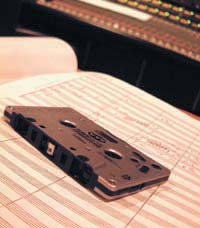Switched ON
Back to Contents of Issue: May 2002
|
|
|
|
|
|
 MY FIRST IMPRESSION OF this gadget was that it resembled one of those (un)useless Japanese inventions (see
The Chindogu Champion, April 2002), as it bizarrely combines MP3 (and other format) digital recording and cassette tape functions. With cassette tapes rapidly going out of fashion and MP3 as the latest medium for recording and storing music, this seems an odd coupling, and you may well question its purpose. Add to that the fact that the whole gadget is shaped like a cassette tape (you don't
have to insert it into a player to listen), and you have an even odder concept. MY FIRST IMPRESSION OF this gadget was that it resembled one of those (un)useless Japanese inventions (see
The Chindogu Champion, April 2002), as it bizarrely combines MP3 (and other format) digital recording and cassette tape functions. With cassette tapes rapidly going out of fashion and MP3 as the latest medium for recording and storing music, this seems an odd coupling, and you may well question its purpose. Add to that the fact that the whole gadget is shaped like a cassette tape (you don't
have to insert it into a player to listen), and you have an even odder concept.
But for me -- a composer and musician -- the Ravemetal does in fact have a couple of advantages. When I first got it home I spent some time trying to work out the recording method: It should have been simple, but when I put it in my home stereo's cassette deck to do a test recording from a CD, all I got was the ambient recording through the built-in microphone. It recorded only the noise of the muffled sound entering the cassette deck from the external speakers of my stereo, not from the CD. After checking through the manual, I still couldn't get it to work, but this turned out not to be a problem with my technical understanding and seemed simply a fault in the particular model I was trying out. Anyway, it was easily exchanged, but in fact the problem was a mismatch with my three-head home cassette player. It does work -- I've checked -- in a two-head deck. Anyway, apart from that, the replacement works. It records digitally onto a built-in memory. I used the 128-MB version, but the basic model comes with 64 MB, and you can go up to 256 MB. The quirky aspect of the Ravemetal is that it is housed in a cassette tape body and the recording is readable -- via its special head -- by any analog cassette player. Plus, you can use the machine alone with headphones Walkman-fashion, as the body sports all the control buttons you need.
As I said, cassettes are going out of fashion, so what are the advantages of this? Well, for me as a composer the biggest is simply that I can record a composition-in-progress onto it and that recording can be played back in my own home stereo or, usefully for me, in my car stereo (fewer cars have cassette decks than before, but mine still has one). As I'm driving, I can listen to a composition to assess the balance and sound of a work-in-progress (and incidentally, hear what the final composition may sound like on a home stereo rather than studio quality). I also then have a recording that can be transported to someone else's place and listened to with headphones or on their home stereo. Of course, I could burn a CD of a composition (and via an MP3 converter, I can send this via email) without using Ravemetal but, as I may want such early stage recordings for only a day or so, that can seem like a waste, even with rewritable CD-RWs (which, being more expensive than CD-Rs, add to that feeling of waste). So, that is also where Ravemetal's value comes in -- its feeling of disposability, rather than permanence. That short-term use also comes into consideration with the sound quality. It's not that good -- somewhere between regular cassette and metal tape. Anyway, MP3 -- to my ears -- has yet to produce real quality sound and you won't want to use it for anything where quality is needed. However, although digital, when recording in a regular cassette deck it uses analog (via its converter) and that analog sound can, within the limitations of its sound quality anyway, sound attractive to me.
The Ravemetal caused some double-takes from onlookers. My voice teacher's wife was puzzled by a disembodied cassette tape doing its own recording, for example. When in the recording studio where the strings were being laid down for a new song I'd composed, I could simply insert the tape into the studio cassette deck to get a personal copy -- odd, at first glance, to the studio technician, but it also attracted interest. Like any innovative product, this is at first glance rather pointless but, within the scope of its design, it does provide a useful new way to approach recording music. Oh, and rather than the anonymous curves and up-to-date design of usual MP3 players, this looks like a cassette, and I kind of like that. @ |
|
Note: The function "email this page" is currently not supported for this page.






